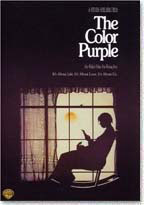 The Color Purple takes place in the Southern United States during the early 1900s to late 1940s, the movie tells the life of a poor African American woman named Celie Harris (Whoopi Goldberg) whose abuse begins when she is young.
The Color Purple takes place in the Southern United States during the early 1900s to late 1940s, the movie tells the life of a poor African American woman named Celie Harris (Whoopi Goldberg) whose abuse begins when she is young.
By the time she is 14, she has already had two children by her father (Leonard Jackson). He takes them away from her at childbirth and forces the young Celie (Desreta Jackson) to marry a wealthy young local widower Albert Johnson, known to her only as “Mister” (Danny Glover), who treats her like a slave.
Albert makes her clean up his disorderly household and take care of his unruly children. Albert beats her often, intimidating Celie into submission and near silence. Celie’s sister Nettie (Akosua Busia) comes to live with them, and there is a brief period of happiness as the sisters spend time together and Nettie begins to teach Celie how to read. This is short-lived; after Nettie refuses Albert’s predatory affections once too often, he kicks her out. Before being run off by Albert, Nettie promises to write to Celie.
Eventually, Celie opens a haberdashery in Tennessee selling one-size-fits-all slacks. Upon the death of her father, she learns that he was, in fact, her stepfather, and that she has inherited a house and shop from her real father. She opens her second slacks shop next to her home named Miss Celie’s Folks Pants.
Steven Spielberg’s first cinematic attempt to delve deeper than escapism produced a rich, heartfelt epic that matched the Pulitzer Prize-winning credentials of Alice Walker’s novel, receiving 11 Oscar nominations but famously winning none of them. The Color Purple is a triumph of all elements of production design, nominated for its screenplay, cinematography, makeup, costumes, art direction, score, and three of its actresses – though not for director Spielberg.
The snub may have helped push him as an artist toward such prestigious works as Schindler’s List. One would hardly guess Whoopi Goldberg’s roots were in comedy, given the layered dramatic performance she offers in her first real screen role. Oprah Winfrey (also debuting) and Margaret Avery are the other two-thirds of the heart-breaking dynamic between three black women in Spielberg’s brutal world of racial and sexual prejudice.
Even Danny Glover’s role shows late-blooming sympathy, however agonizingly wrought, which demonstrates the dimension of Menno Meyjes’ script. There’s nothing simple about this early 20th century South, populated by characters paralyzed by the roles ascribed to them, and wickedly punished when they try to venture beyond their bounds. It boils the blood at the same time that it touches the soul, making for genuinely tear-soaked cinema with a visceral emotional payoff.
Director: Steven Spielberg
Year of Release: 1985
![]()
Character to watch: Whoopi Goldberg as Celie Harris.
Journal your answers to the following questions after you watch the movie.
- How does this particular character’s journey compare with yours?
- Did the character develop certain characteristics during the movie that you have or that you would like to have? If so, what are those characteristics?
- What obstacles did this character face? What was his or her biggest challenge?
- What would you have done differently if you had been in the same position as the character?
- Is this character the type of person you would be friends with? Why or why not?